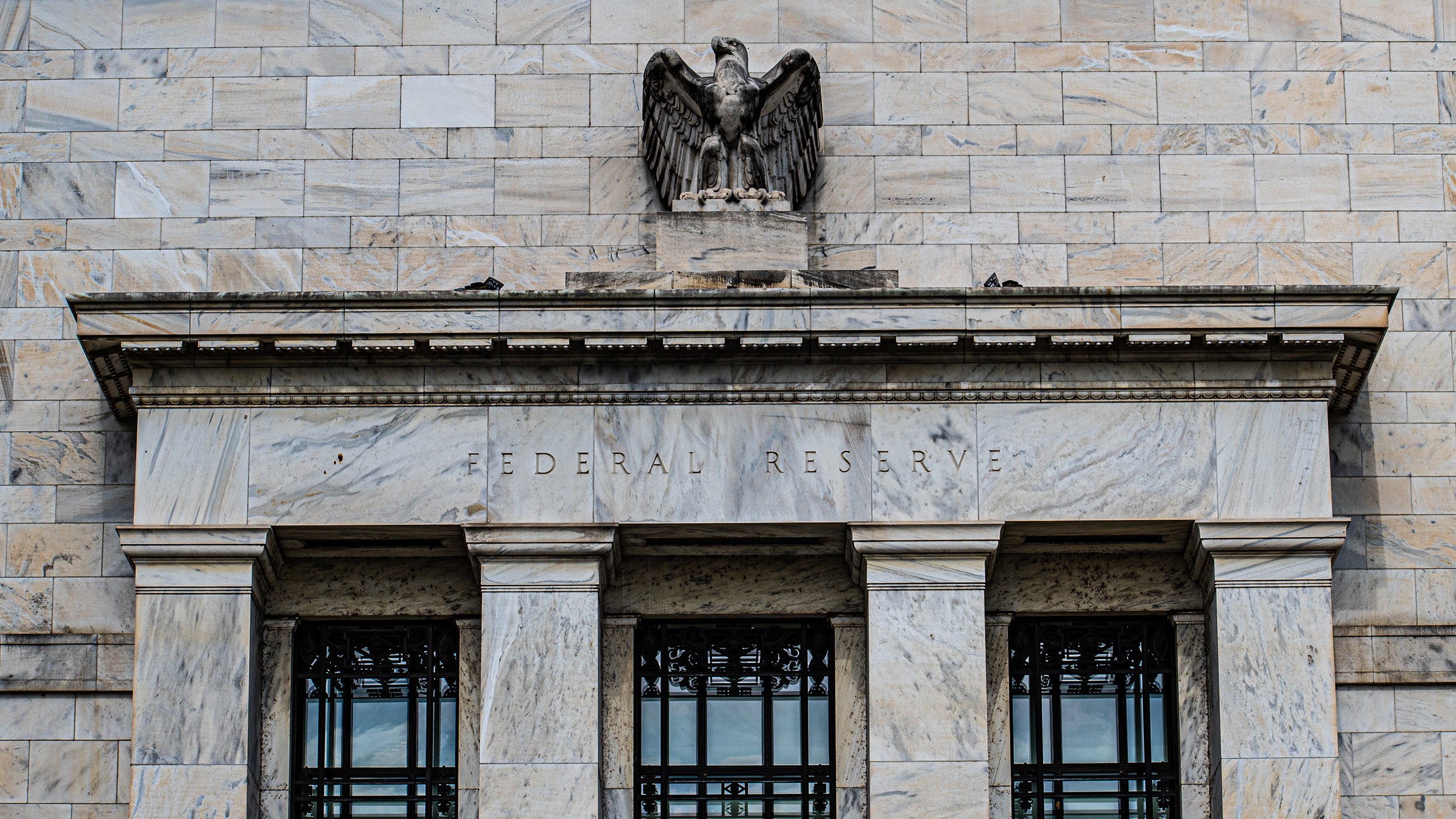
Markets and Economy European stock markets surge as US stock market sags
European nations prepare to invest in defense and infrastructure, while the US faces the possibility of recession brought on by government spending cuts.

After a year of wondering, data indicates that we can expect to see the first Federal Reserve interest rate cut soon.
Artificial intelligence (AI) demands a massive amount of power, providing a structural tailwind for energy infrastructure.
Significant leverage, economic excess, plunging survey data, and widening corporate bond spreads aren't in sight.
Dark Helmet: When will then be now?
Colonel Sandurz: Soon.
Dark Helmet: How soon?
As the market assesses the timing of the first Federal Reserve (Fed) rate cut, I began this month’s article with the movie Spaceballs and the genius of Mel Brooks. After a year of asking “when will then be now,” the policy clarity that investors have desired appears to be forming. The first interest rate cut is expected soon. How soon? The implied rate suggests that the first cut may be coming in September.1 Inflation has significantly moderated,2 and US growth is clearly slowing.3 If the Fed is paying attention, then it’s likely that “then” will be now soon.
…value and smaller-capitalization stocks have tended to outperform growth and mega-cap stocks as the yield curve has normalized.4 The difference between the 10-year and 2-year US Treasury rates troughed at -1.08% one year ago and narrowed to 0.22% by mid-July as the market priced in future rate cuts.5 With multiple rate cuts potentially to come over the next year, the much-anticipated broadening of markets may be in its early stages.
First, there would be signs of significant leverage and excess in the economy. There isn’t. The annual change in business borrowing is essentially flat.6 Also, the challenge for the economy hasn’t been cyclical excess but rather not enough business inventories7 and homes,8 to name a few.
Second, survey data would be plunging. It isn’t. For example, consumer sentiment bottomed in June 2022 and is above past recession levels.9 In addition, the Institute for Supply Management’s survey of purchasing managers in the manufacturing sector bottomed over a year ago and has been hovering between signaling expansion and contraction but remains well above recession-level troughs.10
Finally, the corporate bond spreads, which tend to be the “canary in the coal mine,” would be widening. They aren’t. Borrowing costs for US businesses remain significantly below the long-term average and levels reached ahead of past recessions.11 (Coal miners no longer use canaries to detect toxic gases, if anyone is wondering.)
A: The date I received the question is provided because the 10-year US Treasury rate has declined since then. The question is still worth answering, though, because it will come up again. First, some definitions:
A bond vigilante is a bond market investor who sells bonds to protect against government policies that they believe are inflationary or expansionary.
The “Liz Truss moment“ refers to the poorly received fiscal plans of the UK prime minister, which brought the UK bond market to the brink of disaster and resulted in her ouster.
No, the rise in interest rates in late June/early July wasn't “the Liz Truss moment” nor the return of the bond vigilantes. Risk assets performed well during that period,12 and the US dollar was strong.13 There’s little reason to believe that US Treasury rates are trading on anything else but the nominal growth potential of the US economy. Cyclically, with the US economy slowing and inflation moderating, rates are more likely to fall than to concern themselves in the near term with the fiscal plans of the next US administration.
“Now that inflation has come down and the labor market has indeed cooled off, we’re going to be looking at both mandates. They’re in much better balance.”
—Fed Chair Jerome Powell
Better late than never! The mandates are in better balance, but the balance of risk now skews to the growth side. The time has come to stop fighting the inflation war and instead focus on shoring up employment as modest cracks are emerging.
I’m consistently perplexed by the idea that one party or the other is better for markets. I’ve tried to fight the battle but appear to be losing. My inbox is inundated with notes “helping” me to trade based on Donald Trump’s improving odds to win the presidency. I’m being told the Trump trade is long crypto and European defense stocks and short Chinese stocks. It’s almost as if bitcoin prices and European defense stocks didn’t double and Chinese stocks didn’t decline under the first 3.5 years of Joe Biden’s term.14
For those keeping score, the S&P 500 Index was up 70.2% from the day Donald Trump was elected until the day Joe Biden and Kamala Harris were elected. Since then, it’s up 76.4%.15 Growth outperformed value under Trump. Growth outperformed value under Biden and Harris.16
Can we stop this already? I promise to keep fighting this losing battle.
The Fed was late in raising interest rates in the aftermath of the pandemic. Some are now arguing that they should have been cutting interest rates months ago. Why, then, do we let bureaucrats determine short-term rates rather than rely on the free market? I posed the question to Arnab Das, Global Macro Strategist at Invesco. His response:
“If you have a fiat currency, you must have an anchor for inflation. Targeting inflation requires the setting of interest rates. It can’t be left to the market. The alternative would be something like a gold standard or inviolable rules such as the Taylor rule or a money growth rule. Reverting to the gold standard or to a set of rules would require tolerating more interest rate volatility and would likely result in a less financialized economy. It would also likely result in more severe economic downturns, as there wouldn't be a policy authority with the tools required to counteract severe recessions.”
The Greater Possibilities podcast welcomed Brian Watson, Invesco Portfolio Manager and Director of Master Limited Partnerships (MLPs), to talk about the energy infrastructure market. It's coming soon. My takeaways:
To get this podcast and other upcoming episodes, subscribe to our podcasts.
I tend to accrue fewer travel miles during the dog days of summer. Rather than regale you this month with tales from my work travel, I’ll offer an observation from recent weekend travels to different vacation spots on Long Island and the Jersey Shore. Let’s just say that I’ve never seen these locations more crowded. The line for the exercise machines at a YMCA in eastern Long Island was stunning, and don’t get me started on the restaurant waitlists. The US economy may be slowing, but anecdotally, Americans still seem to be showing themselves a pretty good time.
I’ll conclude with quotes from Presidents Trump and Biden, respectively. “This is a chance to bring the whole country… together.” “It’s time to cool (the political rhetoric) down.” I hope so, and I couldn’t agree more.
Source: Bloomberg L.P., 7/15/24. Based on the fed funds implied rate, which is the rate equal to the difference between the spot rate and the forward or futures rate.
Source: US Bureau of Labor Statistics, 6/30/24. Based on the annual change in the Consumer Price Index, which measures changes in consumer prices as determined by the US Bureau of Labor Statistics.
Source: Bloomberg L.P., 6/30/24. Based on a variety of metrics, including the ISM PMI Manufacturing Index, a commonly cited indicator of the manufacturing sector’s economic health, calculated by the Institute of Supply Management, and initial jobless claims.
Source: Bloomberg L.P., 7/15/24. Based on the performance of Russell 1000 Value compared to Russell 1000 Growth and Russell 2000 compared to S&P 500. Russell 1000 Value Index measures the performance of value-oriented stocks. Russell 1000 Growth Index measures the performance of growth-oriented stocks. Russell 2000 Index measures the performance of small-capitalization stocks. The S&P 500 Index is a market-capitalization-weighted index of the 500 largest domestic US stocks. An investment cannot be made directly into an index. Past performance does not guarantee future returns.
Source: Bloomberg L.P., 7/15/24.
Source: US Federal Reserve, 3/31/24. Latest data available. Based on the year-over-year percent change in debt and liabilities of nonfinancial corporate businesses.
Source: US Census Bureau, 6/30/24. Based on the US retail inventory-to-sales ratio.
Source: Bloomberg Intelligence, 3/31/24. Based on residential investment as a percentage of gross domestic product.
Source: University of Michigan Consumer Sentiment Index, 6/30/24. It’s published monthly, based on a telephone survey designed to assess US consumer expectations for the economy and their personal spending.
Source: Institute for Supply Management, 6/30/24.
Source: Bloomberg L.P., 7/15/24. Based on the option-adjusted spread of the Bloomberg US Corporate Bond Index, which measures the investment grade, fixed-rate, taxable corporate bond market. It includes USD-denominated securities publicly issued by US and non-US industrial, utility, and financial issuers. Option-adjusted spread (OAS) is the yield spread which must be added to a benchmark yield curve to discount a security’s payments to match its market price, using a dynamic pricing model that accounts for embedded options.
Source: Bloomberg L P. Based on the S&P 500 Index.
Source: Bloomberg L.P. Based on the US Dollar Index (DXY), which measures the value of the US dollar against a trade-weighted basket of currencies.
Source: Bloomberg L.P., 7/15/24. Based on the price performance of bitcoin, the performance of the MSCI Europe Aerospace & Defense Net Total Return Local Index, and the performance of the MSCI China Index from inauguration day 2021 through the middle of July 2024.
Source: Bloomberg L.P., 7/15/24.
Source: Bloomberg L.P., 7/15/24. Based on the returns of the Russell 1000 Growth and Russell 1000 Value Indexes from election day 2016 to election day 2020, and from election day 2020 to the middle of July 2024.
Source: Bloomberg L.P., 6/30/24. Based on the performance of the Alerian MLP Index and the S&P 500 Index from March 2020 to June 2024. The Alerian MLP Index is a float-adjusted, capitalization-weighted index measuring master limited partnerships, whose constituents represent approximately 85% of total float-adjusted market capitalization.
Source: Alerian, Vetta Fi, and Wells Fargo Securities, 6/30/24.
Source: Goldman Sachs, “Generational Growth AI, data center and the coming US power demand surge,” 4/28/24.
Source: Alerian, Vetta Fi, and Wells Fargo Securities, 6/30/24. Based on the enterprise value divided by earnings before interest, taxes, depreciation, and amortization of the Alerian MLP Index.

European nations prepare to invest in defense and infrastructure, while the US faces the possibility of recession brought on by government spending cuts.

The market is gauging the economic inefficiencies that may result from the Trump administration’s new tariffs and the retaliatory measures from other countries.

The US economy appears to be slowing quickly as consumers brace for tariffs, higher prices, and a possible government shutdown.
Important information
NA3731548
Image: Douglas Rissing / Getty
Past performance does not guarantee future results. An investment cannot be made directly into an index.
Stocks of small companies tend to be more vulnerable to adverse developments, may be more volatile, and may be illiquid or restricted as to resale.
A value style of investing is subject to the risk that the valuations never improve or that the returns will trail other styles of investing or the overall stock markets.
Growth stocks tend to be more sensitive to changes in their earnings and can be more volatile.
The risks of investing in securities of foreign issuers can include fluctuations in foreign currencies, political and economic instability, and foreign taxation issues.
An investment in emerging market countries carries greater risks compared to more developed economies.
Most MLPs operate in the energy sector and are subject to the risks generally applicable to companies in that sector, including commodity pricing risk, supply and demand risk, depletion risk and exploration risk. MLPs are also subject the risk that regulatory or legislative changes could eliminate the tax benefits enjoyed by MLPs which could have a negative impact on the after-tax income available for distribution by the MLPs and/or the value of the portfolio’s investments.
Bitcoins are considered a highly speculative investment due to their lack of guaranteed value and limited track record. Because of their digital nature, they pose risk from hackers, malware, fraud, and operational glitches. Bitcoins are not legal tender and are operated by a decentralized authority, unlike government-issued currencies. Bitcoin exchanges and Bitcoin accounts are not backed or insured by any type of federal or government program or bank.
The yield curve plots interest rates, at a set point in time, of bonds having equal credit quality but differing maturity dates to project future interest rate changes and economic activity.
Credit spread is the difference in yield between bonds of similar maturity but with different credit quality.
The federal funds rate is the rate at which banks lend balances to each other overnight.
The Institute of Supply Management (ISM) Manufacturing Purchasing Managers Index (PMI) Report on Business is based on data compiled from monthly replies to questions asked of purchasing and supply executives in over 400 industrial companies.
The opinions referenced above are those of the author as of July 18, 2024. These comments should not be construed as recommendations but as an illustration of broader themes. Forward-looking statements are not guarantees of future results. They involve risks, uncertainties, and assumptions; there can be no assurance that actual results will not differ materially from expectations.
This link takes you to a site not affiliated with Invesco. The site is for informational purposes only. Invesco does not guarantee nor take any responsibility for any of the content.